Wolves are undoubtedly large, strong, fast, and terrific hunters with guts and brute.
Whether they are famed for size or hunting prowess, it is impossible to displace them from their apex position in various wildlife ecosystems.
Like wild cats, bears, elephants, or other members of the jungle, wolves also exist in their various species and subspecies, roaming across different geographical ranges.
The gray and red wolf are the world’s most popular types of wolves, but the Mongolian wolf, tundra wolf, and others are among the large family of wolf subspecies.
Read on to discover the different extant and extinct wolf species, including their size in various metrics and their conservation statuses.
Different Types of Wolves – Extant Species
1. Gray Wolves
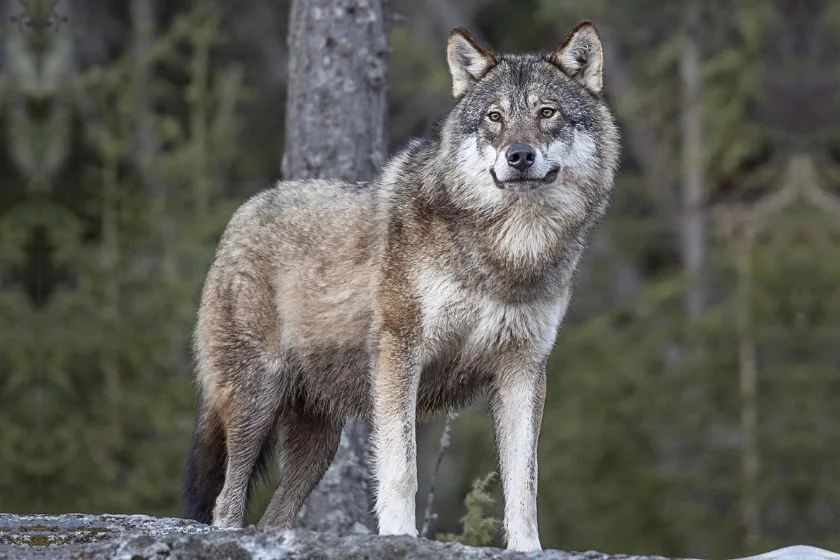
- Scientific name: Canis lupus
- Height: 2 feet, 2 inches – 2 feet, 8 inches
- Weight: 23 – 80 kg
- Length: 4 feet, 6 inches – 6 feet
- Conservation Status: Least Concern
The gray wolf is a widely-known species and one of the exotic wildlife in North America, existing mostly in wildernesses around Greenland, Alaska, Canada, and the Northern United States.
These species are intimidating due to their large sizes, measuring around six feet long and reaching two feet, eight inches in height, with powerful jaws and teeth and powerful bodies for large-scale and complex hunting.
They are social species, hunting in packs to meet their three-to-four-pound food requirement daily.
As such, a pack can prey on larger animals like moose, caribou, and bison.
While the gray wolf is a major species, several subspecies fall under the “Canis lupus” taxonomic classification.
2. Red Wolf

- Scientific Name: Canis rufus
- Height: 2 feet, 2 inches
- Weight: 23 – 39 kg
- Length: 4 feet, 5 inches – 5 feet, 3 inches
- Conservation Status: Critically Endangered
The red wolf is one of the largest and most popular wolf species. It is a major species, unlike some gray wolf subspecies we will consider.
Red wolves measure between four and five feet long and are over two feet in height; still, they weigh roughly forty kilograms.
The red wolf is characterized by its tawny or grayish coat complemented by light markings around the face.
Raccoons, nutria, white-tailed deer, and rabbits in northeastern North Carolina, where they were reintroduced in 1987, are their primary diet in the wild.
3. Mongolian Wolf
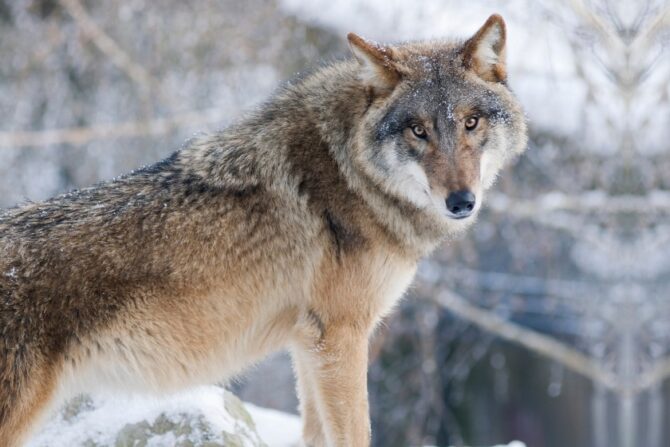
- Scientific Name: Canis lupus chanco
- Height: 1 foot, 11 inches – 2 feet 11 inches
- Weight: 22 – 30 kg
- Length: 3 feet, 6 inches
- Conservation Status: Near Threatened
The Mongolian wolf is a gray wolf subspecies renowned for its tremendous size, growing over three feet long, roughly three feet tall, and weighing about twenty-two to thirty kilograms.
The wolf subspecies exist in Russia, China, and Korea, distinct from other wolf species, thanks to its brownish-yellow, dull orange, or tawny coat with gray and black hairs scattered all over.
Pure white fur on the throat, chest, belly, and inside legs also complements the wolf’s beautiful coat.
4. Himalayan Wolf

- Scientific Name: Canis lupus chanco
- Height: 2 feet, 6 inches
- Weight: 35 kg
- Length: 3 feet, 7 inches
- Conservation Status: Endangered
Controversies exist about the Himalayan wolf’s genetic similarities to the Tibetan and Mongolian wolves.
Still, it is uniquely characterized by its adaptation to harsh, high-altitude life.
This species has a thick, wooly coat for colder climates and tolerance to the low oxygen level at high elevations.
One can identify the wolf by its yellowish-white fur on the limbs, face, and belly with dull earthy-brown hairs rooted on the back and tail.
Himalayan wolves are endangered in their natural range of the Himalayas mountains, the Central Asian mountains, the Tibetan Plateau, and Ladakh, India.
They are also large-sized wolves growing up to 2.5 feet in height, 3.6 feet in length, and 35 kilograms in weight as adults.
5. Steppe Wolf (Caspian Sea Wolf)

- Scientific Name: Canis lupus campestris
- Height: 2 feet, 4 inches
- Weight: 35 – 40 kg
- Length: 4 feet
The Caucasus and Caspian steppes and steppes of the lower European part of the former Soviet Union are home to the Caspian Sea wolf, also called the steppe wolf.
These are large-sized wolves notorious for bearing rabbits; nevertheless, they count among the wolf species one must know.
They are occupants of the large, flat unforested grasslands in south-eastern Europe.
They may reach four feet in length, over two feet in height, and weigh no less than thirty-five kilograms as adults.
These species have a distinctive mix of light gray, rusty gray, brown, and black hairs scattered across their flanks and backs.
However, Middle Asia and Kazakhstan variants may have more reddish tones and poorly furred tails.
6. Tundra Wolf
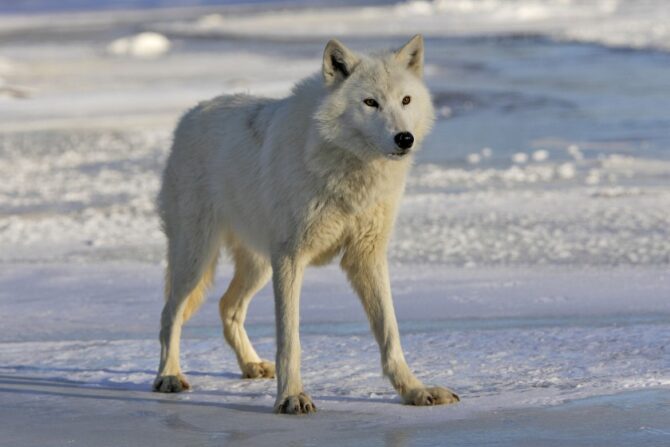
- Scientific Name: Canis lupus albus
- Height: 2 feet, 4 inches – 3 feet, 2 inches
- Weight: 36.6 – 49 kg
- Length: 3 feet, 10 inches – 4 feet, 6 inches
- Conservation Status: Near Threatened
Eurasia’s tundra and forest-tundra zones are not exempted from a population and its subspecies of gray wolves.
The tundra wolf is endemic to this region, occupying the region’s river valleys, thickets, and forest clearings.
This species’ light gray, fluffy, long, dense, and soft coat differentiates it from its counterparts.
Still, its primary diet is akin to its geographic range, feeding on small rodents, hares, reindeer, arctic foxes, and birds.
Little wonder they can grow over three feet tall, almost fifty kilograms, and 4.5 feet long.
7. Arctic Wolf
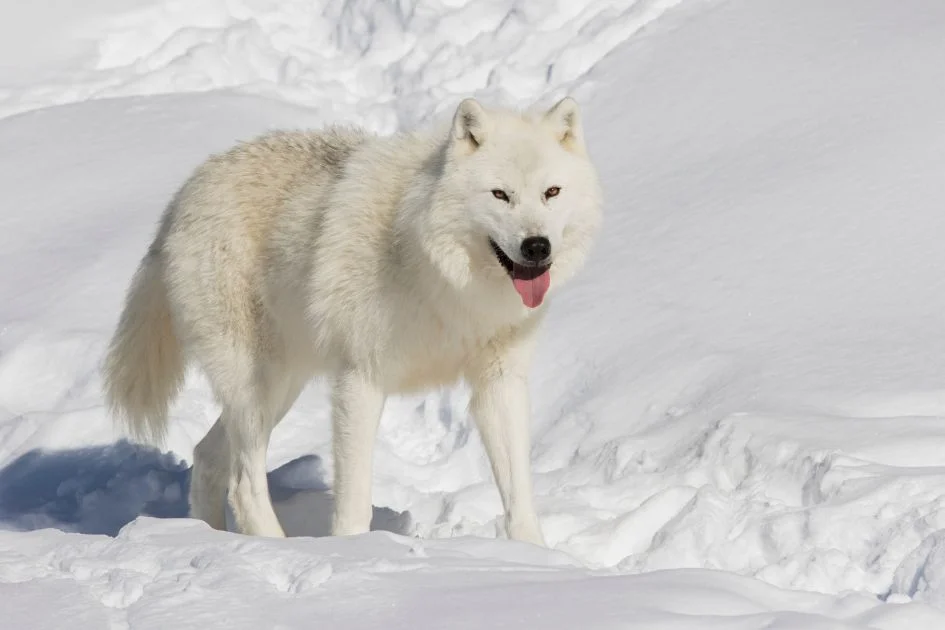
- Scientific Name: Canis lupus arctos
- Height: 3 feet
- Weight: 34 – 46 kg
- Length: 3 feet, 2 inches – 5 feet, 10 inches
- Conservation Status: Least Concern
One might expect to find polar bears and seals in the arctic regions, but a subspecies of gray wolves also have adaptive modifications and tolerance for these colder regions.
While similar subspecies shuffle tundra and forest regions, arctic wolves occupy Canada’s high arctic tundras, inhabiting the northern treeline.
They also live in the glacier regions of Alaska, Greenland, and Iceland.
The arctic wolf may reach three feet tall, five feet long, and weigh almost fifty kilograms, consuming arctic hares, muskoxen, and caribou to meet its daily twenty pounds of meat requirement.
8. Northern Rocky Mountain Wolf
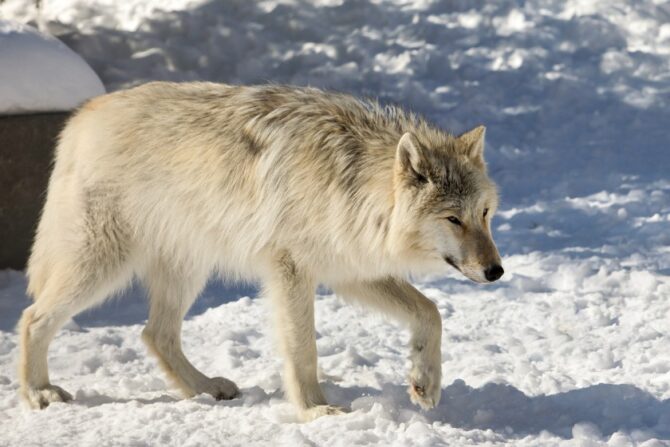
- Scientific Name: Canis lupus irremotus
- Height: 2 feet, 2 inches – 2 feet, 8 inches
- Weight: 32 – 68 kg
- Conservation Status: Apparently Secure
While the major species, gray and red wolves, are the most common canines in the wolf pack, the northern Rocky Mountain wolf is popular among native Americans down memory lane as a sacred species.
This species has not lost its significance through the centuries as it ranks among the world’s largest wolves and is certainly an extant wolf species one must know.
The northern Rocky Mountain wolf measures around two feet eight inches tall and can reach sixty-eight kilograms.
Without a doubt, such a large-sized wolf must have a large appetite.
Therefore, the northern Rocky Mountain wolf consumes about 10-21% of its body mass, feeding on elk, mule deer, beaver, and bison, common animals within the North American range.
Sadly, such a large appetite forces the wolf into cannibalism when there is an extremely short food supply.
Unevaluated by the IUCN, the northern Rocky Mountain wolf is “Apparently Secure” under NatureServe conservation status.
9. Eurasian Wolf

- Scientific Name: Canis lupus lupus
- Height: 2 feet, 7 inches – 2 feet, 9 inches
- Weight: 69 – 80 kg
- Length: 3 feet, 5 inches – 5 feet, 3 inches
- Conservation Status: Least Concern
The list would be incomplete without the common wolf, also called the Eurasian wolf, an endemic species of Asia and Europe.
The Eurasian wolf is one of the most common and largest Old World gray wolves.
Adult individuals average thirty-nine kilograms but can double in weight, measuring over two feet seven inches tall and five feet three inches long.
Eurasian wolves have relatively short and tawny coarse coats, unlike the arctic and tundra wolves.
Nevertheless, these coats are beautiful, with white markings on the throat and cheeks complementing them.
The common wolf primarily preys on moose, wild boar, red deer, and roe deer, but saiga, reindeer, fallow deer, wild goats, and musk deer make up secondary targets.
10. Interior Alaskan Wolf (Yukon Wolf)
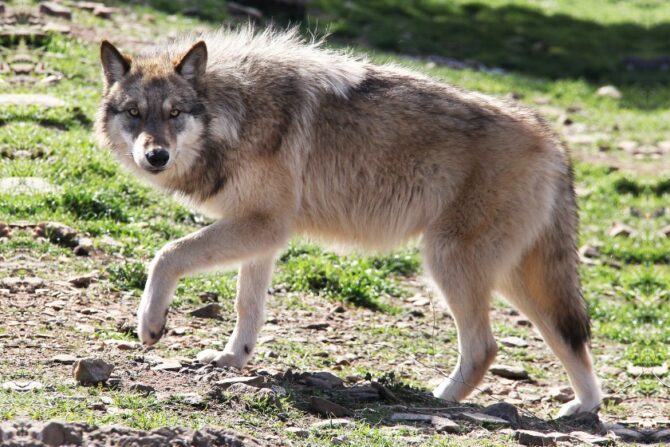
- Scientific Name: Canis lupus pambasileus
- Height: 2 feet, 9 inches
- Weight: 32 – 60 kg
- Length: 4 feet, 11 inches – 6 feet, 5 inches
- Conservation Status: Least Concern
As the name implies, the Interior Alaskan wolf, also called the Yukon wolf, is endemic to the arctic regions of Alaska, and Canada, including the Yukon, British Columbia, and the Northwest Territories.
These tawny gray or tan-coated, large-sized wolves inhabit boreal forests, alpine, subalpine, and Arctic tundras, primarily differing from the Eurasian and northwestern wolf with a larger head, thicker muzzle, and robustness.
They grow between 38.5 – 56.3 kilograms in weight, standing almost three feet tall and measuring between four and six feet long.
Interior Alaskan wolves have a wide range of diets, preying differently by region.
However, expect to find them hunting boreal woodland, barren-ground caribou, moose, and Dall sheep.
11. Northwestern Wolf
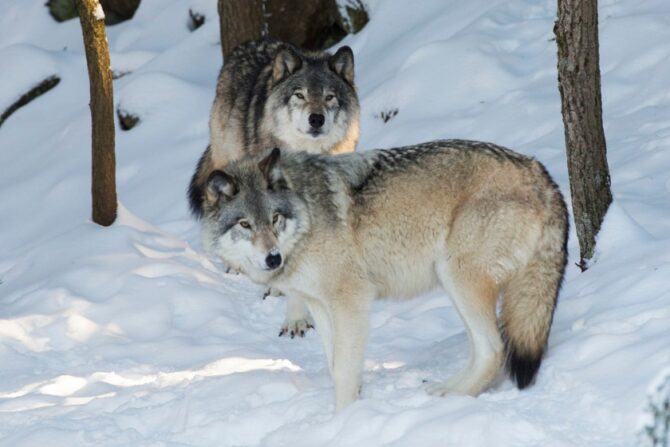
- Scientific Name: Canis lupus occidentalis
- Height: 2 feet, 2 inches – 3 feet
- Weight: 45 – 72 kg
- Length: 5 feet – 7 feet
- Conservation Status: Apparently Secure
The northwestern wolf is a gray wolf subspecies occupying the geographical range of the northwest United States (from which its name is coined), Alaska, and the upper Mackenzie River Valley, extending to the western Canadian provinces.
While the northwestern wolf is not outstandingly tall, it can reach seven feet long but is usually between five and six feet, making it the biggest wolf in the world.
It feeds on bison and elk, hunting the youngest or weakest members of the herd.
12. Arabian Wolf
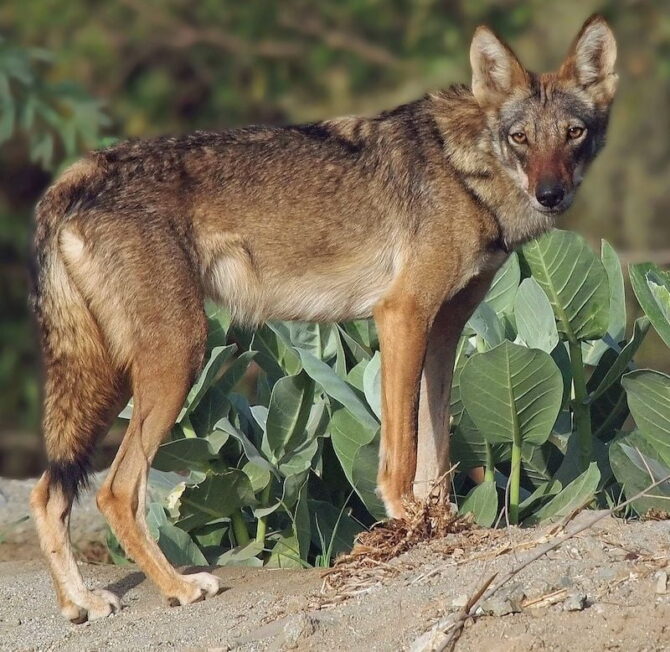
- Scientific Name: Canis lupus arabs
- Height: 2 feet, 1 inch – 2 feet, 2 inches
- Weight: 20.41 kg
- Conservation Status: Critically Endangered
Have you ever wondered if wolves inhabit deserts as they occur in tundra and forested environments?
The Arabian wolf fits that profile as it occupies western and southern Iraq, Saudi Arabia, Jordan, Yemen, southern Israel, some parts of Egypt’s Sinai Peninsula, and Oman.
As such, these wolves have thin, short, and lightly colored fur, an adaptive feature for their geographical range.
Another distinctive feature of the wolf’s appearance is its massive ears.
Unlike their tundra and arctic counterparts, the Arabian wolf is small-sized, standing around two feet and weighing about twenty kilograms.
13. Indian Wolf
- Scientific Name: Canis lupus pallipes
- Height: 1 foot, 10 inches – 2 feet, 4 inches
- Weight: 17 – 25 kg
- Length: 3 feet, 4 inches – 4 feet, 9 inches
- Conservation Status: Endangered
While India might be more popular for tigers and Asian lions, they also have a population of wolf subspecies, the Indian wolf.
However, populations spread across parts of Pakistan and Iran, with Turkey occasionally recording sightings.
The Indian wolf inhabits forested areas in the country’s Peninsular and sometimes in parts of the Himalayas mountains.
It is also a small species like the Arabian wolf. However, it is uniquely coated in reddish-gray and white, with the upper body covered in the earlier color and the belly and legs in white markings.
Indian wolves have smaller packs than other gray wolf subspecies, with clans usually between six and eight individuals. They are also less vocal than their counterparts.
Therefore, these features account for easier identification among Himalayan wolf populations occurring in the Himalayas.
14. Mexican Wolf
- Scientific Name: Canis lupus baileyi
- Height: 2 feet, 4 inches – 2 feet, 8 inches
- Weight: 22 – 36 kg
- Length: 5 feet, 6 inches
- Conservation Status: Critically Imperiled (NatureServe); Endangered (ESA)
The Mexican wolf, the smallest of North America’s gray wolves and perhaps the rarest in the continent, is a critically endangered species flagged “Critically Imperiled” by NatureServe.
The wolf has distinctive features, including a yellowish-gray pelt overcast with black on the back and tail and a smaller, narrower skull that differentiates it from the Great Plains wolf, an infamous subspecies among native Americans.
After extirpation in the wild during the mid-1900s, the Mexican wolf is back to its historical range in Arizona and New Mexico thanks to a captive breeding program between the United States and Mexico.
15. British Columbian Wolf
- Scientific Name: Canis lupus columbianus
- Weight: 36 – 68 kg
- Length: 5 feet – 5 feet, 10 inches
- Conservation Status: Apparently Secure (NatureServe)
While the British Columbia wolf of Vancouver Island, British Columbia, Yukon, and southeast Alaska is one of the largest subspecies of North American wolves, a fascinating fact about the Canadian canine is its appearance.
Most North American wolves have lighter-colored coats, unlike the British Columbian wolf’s long coats, usually black and often mixed with brown or grey.
Typical of wolves, the British Columbian subspecies prey on some rodents and ungulates, including hares, elk, deer, caribou, and moose.
16. Vancouver Coastal Island Wolf
- Scientific Name: Canis lupus crassodon
- Height: 2 feet, 2 inches – 2 feet, 8 inches
- Weight: 27 kg
- Length: 4 feet – 5 feet
- Conservation Status: Least Concern
The Vancouver coastal island wolf is one canine with incredible aquatic abilities, swimming up to eight miles from Bella Bella, British Columbia, to the big island off the coast.
Their aquatic locomotion is only one of their remarkable extra-canine features, as these wolves have a fairly unique diet, feeding on fish and relatively small deer.
The Vancouver coastal island wolf is a look-alike of its British Columbian counterpart but lighter in color as white variants appear.
However, most individuals are a mix of brown, grey, and black.
17. Hudson Bay Wolf
- Scientific Name: Canis lupus hudsonicus
- Height: 2 feet, 4 inches – 2 feet, 11 inches
- Weight: 38 – 70 kg
- Length: 3 feet, 11 inches – 4 feet, 11 inches
- Conservation Status: Endangered
The Canadian arctic is not free from wolf populations thanks to the arctic wolf look-alike, the Hudson Bay wolf.
While one might mistake the Hudson Bay wolf’s identity for the arctic wolf, the former is a distinct subspecies with a flatter skull.
The Hudson Bay wolf might not be a popular mention as the remoteness of its range restricts its contact with humans.
Still, elk and caribou, which frequently encounter the Canadian canine, make up its menu.
18. Alexander Archipelago Wolf
- Scientific Name: Canis lupus ligoni
- Height: 2 feet
- Weight: 14 – 23 kg
- Length: 3 feet, 6 inches
- Conservation Status: Vulnerable (NatureServe)
While arctic animals tend to be lighter colored, the Alexander Archipelago wolf majestically rocks its darkly-colored coat, perhaps because the Tongass National Forest covers its range.
Its range encircles south-eastern Alaska, where it primarily preys on the Sitka black-tailed deer.
The beaver, mountain goat, and moose are alternatives when these deer are unavailable.
The Alexander Archipelago wolf enjoys the dense, undeveloped forest of the Tongass, with abundant wildlife for food sources.
19. Eastern Wolf
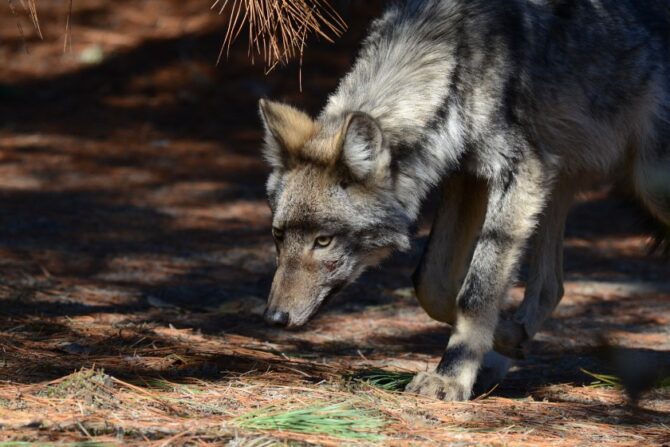
- Scientific Name: Canis lupus lycaon
- Height: 2 feet, 1 inch – 3 inches
- Weight: 24 – 30 kg
- Length: 5 feet, 6 inches
- Conservation Status: Imperiled (NatureServe); Threatened (ESA)
The eastern wolf might be notorious for bold or aggressive behavior towards humans in Algonquin Provincial Park.
Still, its magnificence is undeniable, with a grayish-brown coat complemented by cinnamon, rufous or creamy flank and chest, and a mix of black and gray fur on the shoulders, nape, and tail region.
The eastern wolf’s classification is controversial as some consider it a subspecies of the gray or red wolf or a separate species from both.
The wolf prefers medium-sized prey like beavers and white-tailed deer, and some packs or individuals enjoy blueberries despite being largely carnivorous.
Today, Canadian provinces Ontario and Quebec house the eastern wolf.
However, the wolf’s historic range largely covers North America’s eastern coasts.
20. Mackenzie River Wolf
- Scientific Name: Canis lupus mackenzii
- Height: 2 feet, 8 inches – 3 feet, 4 inches
- Weight: 46 – 62 kg
- Length: 5 feet – 7 feet
- Conservation Status: Secure (NatureServe)
The Mackenzie River wolf is another gray wolf subspecies that exist in Canada.
The southern region of the Northwest Territories houses these wolves; however, the remoteness of their range has limited research about them.
The Mackenzie River wolf diet includes mountain goats, Dall sheep, snowshoe hares, lemmings, and fish like salmon.
21. Baffin Island Wolf
- Scientific Name: Canis lupus manningi
- Height: 2 feet – 3 feet, 6 inches
- Weight: 13.6 – 22.7 kg
- Length: 3 feet, 6 inches
- Conservation Status: Secure (NatureServe)
While NatureServe evaluates the Baffin Island wolf as “Secure,” the light-colored subspecies is amongst the world’s least commonly sighted wolves.
These wolves are similar in color to some other species, with light or white-colored fur turfs.
Still, ruffs of long hair fringing the sides of their faces and an unusually small size of about 3.5 feet in length and thirteen to twenty-two kilograms in weight differentiates the Baffin Island wolf from its counterparts.
Another distinctive feature lies in the wolf’s ecological trait, often hunting alone or in lone pairs of both sexes.
Baffin Island wolves hunt arctic hares, lemmings, and barren-ground caribou.
22. Greenland Wolf
- Scientific Name: Canis lupus orion
- Weight: 26 kg
- Length: 5 feet, 1 inch
While the arctic wolf is native to polar regions, including Greenland, the Greenland wolf (Canis lupus orion) is native to Greenland.
These wolves are similar in look to their arctic counterparts, mostly white-pelted.
However, they are smaller, measuring about five feet in length and less than 30 kilograms, unlike the arctic wolf, which may weigh almost 50 kilograms.
Their range covers northern Greenland, even though history indicates they once roamed the Queen Elizabeth Islands and other parts of Greenland.
The Greenland wolf is far from being a picky eater, with many species, from seals to muskox, meeting their nutritional demands.
23. Alaskan Tundra Wolf
- Scientific Name: Canis lupus tundrarum
- Height: 2 feet, 4 inches – 3 feet, 2 inches
- Weight: 38.5 – 80 kg
- Length: 4 feet, 2 inches – 5 feet, 3 inches
- Conservation Status: Apparently Secure (NatureServe)
The Alaskan tundra wolf is a large-sized wolf endemic to Alaska’s tundra, taiga near the Arctic coast, and boreal forests.
While its name suggests that it is limited to the icy American state, the Alaskan tundra wolf’s range reaches Hudson Bay.
These wolves are mostly white-colored, like many arctic subspecies, and are identical cousins to the Great Plains wolf in skull and tooth morphology and the Interior Alaskan wolf.
However, their narrower rostrum and palate and whiter coat differentiate them from both.
The Alaskan tundra wolf is a ferocious hunter like other wolf subspecies, preying on moose, caribou, muskoxen, and bison.
24. Iberian Wolf
- Scientific Name: Canis lupus signatus
- Height: 2 feet, 3 inches – 2 feet 7 inches
- Weight: 25 – 55 kg
- Length: 4 feet, 7 inches – 5 feet, 11 inches
- Conservation Status: Vulnerable
The Iberian wolf is an identical cousin to the Eurasian wolf but is a distinct subspecies from the latter.
The Iberian wolf has a slighter frame, with white and dark marks on specific parts.
This wolf occupies the northwestern Iberian Peninsula in northern Portugal and northwestern Spain, feeling at home in this range’s forests and mountain ecosystems.
Iberian wolves do not embrace the large pack culture, living in small packs where they hunt red deer, roe deer, ibexes, rabbits, and fish.
While the Iberian wolf is the only Western Europe wolf subspecies whose hunting remains legal, as the Spanish government has refused to raise a brow against it, its population suffers a strong decline, primarily from hunting.
Other causes for the decline include the loss of wild ungulates and habitat degradation, accounting for about 2,000 individuals in roughly 350 packs within their natural geographical range.
25. Italian Wolf
- Scientific Name: Canis lupus italicus
- Height: 1 foot, 8 inches – 2 feet, 4 inches
- Weight: 25 – 45 kg
- Length: 3 feet, 6 inches – 4 feet, 9 inches
- Conservation Status: Vulnerable
The Italian wolf also called the Apennine wolf for inhabiting the Apennine Mountains and the Western Alps, is a gray wolf subspecies controversially considered an indistinctive variant of Eurasian wolves.
However, this wolf type is genetically distinct from its counterparts thanks to its distinct skull morphology.
The Italian wolf differs in appearance across seasons, usually having a grey-fulvous pelt that reddens in summer.
Lighter-colored belly and cheeks, dark bands on the back and tail tip, and occasionally along the forelimbs complement the colorful coat.
Interestingly, the Italian wolf has a rich history among Italians, featuring prominently as far back as pre-Roman culture until a few hundred years ago.
26. Labrador Wolf
- Scientific Name: Canis lupus labradorius
- Weight: 27 – 32 kg
- Length: 4 feet, 4 inches – 6 feet, 2 inches
- Conservation Status: Vulnerable (NatureServe)
The Labrador wolf, endemic to Labrador and northern Quebec, is characterized by its dark grizzly-gray or nearly white coat.
Like Yukon, British Columbia, and specific areas in Canada, Labrador is blessed with a subspecies of gray wolves.
Labrador wolves are close relatives of the extinct Newfoundland wolf and have a vulnerable population.
They primarily hunt white-tailed deer and caribou across tundras, peatlands, coastline wetlands, boreal forests, and the taiga.
27. Great Plains Wolf
- Scientific Name: Canis lupus nubilus
- Weight: 45 kg
- Length: 4 feet, 7 inches – 6 feet, 5 inches
Perhaps not among the widely known wolf subspecies, one can derive pleasure from the fact that the Great Plains wolf is extant.
These wolves were considered extinct until proven otherwise when scientists discovered descendants in the American states of Michigan, Minnesota, and Wisconsin.
The Great Plains wolf is large and mostly lightly colored; white and black variants still appear within individuals.
These wolves feed on moose, white-tailed deer, beaver, snowshoe hare, smaller mammals, and birds.
Extinct Wolf Species
- Dire Wolf (Aenocyon dirus)
- The Japanese Wolf (Canis lupus hodophilax)
- The Cave Wolf (Canis lupus spelaeus)
- Newfoundland wolf (Canis lupus beothucus)
- Kenai Peninsula wolf (Canis lupus alces)
- Cascade mountain wolf (Canis lupus fuscus)
- Florida black wolf (Canis rufus floridanus)
- Texas wolf (Canis lupus monstrabilis)
- Sicilian wolf (Canis lupus cristaldii)
Related Questions
Do wolves attack humans?
Wolves are potentially one of the most dangerous animals to humans due to their immense strength, hunting skills, and predator instincts. However, they rarely attack humans. Wolves are usually wary of humans and mostly steer clear of them.
Can you get a wolf as a pet?
Wolves are among the animals listed in the exotic pet market, but the decision to get one depends on where you live, your dedication to caring for an animal from a long lineage of untamed culture, and your training skills, abilities, and techniques. Many states and cities prohibit citizens from owning pet wolves, and many wildlife lovers might fare badly training and caring for a wolf.
Wrap Up
Wolves, the largest and most exotic of the Canidae family, have a rich history of cultural significance, beauty, and controversy. Moreover, they are large, wild dogs with a fearsome presence in the wild as ferocious hunters and apex predators. Many are only familiar with one or two will species. However, our article on the different types of wolves is comprehensively researched and written to discuss the extant/extinct species and fun facts about the wild clan.
While some species have stable populations and require little conservation concern, others are declining and on the verge of extinction due to overhunting and habitat degradation. Therefore, it will help if we all support conservation efforts to ensure the continuity of these animals.






